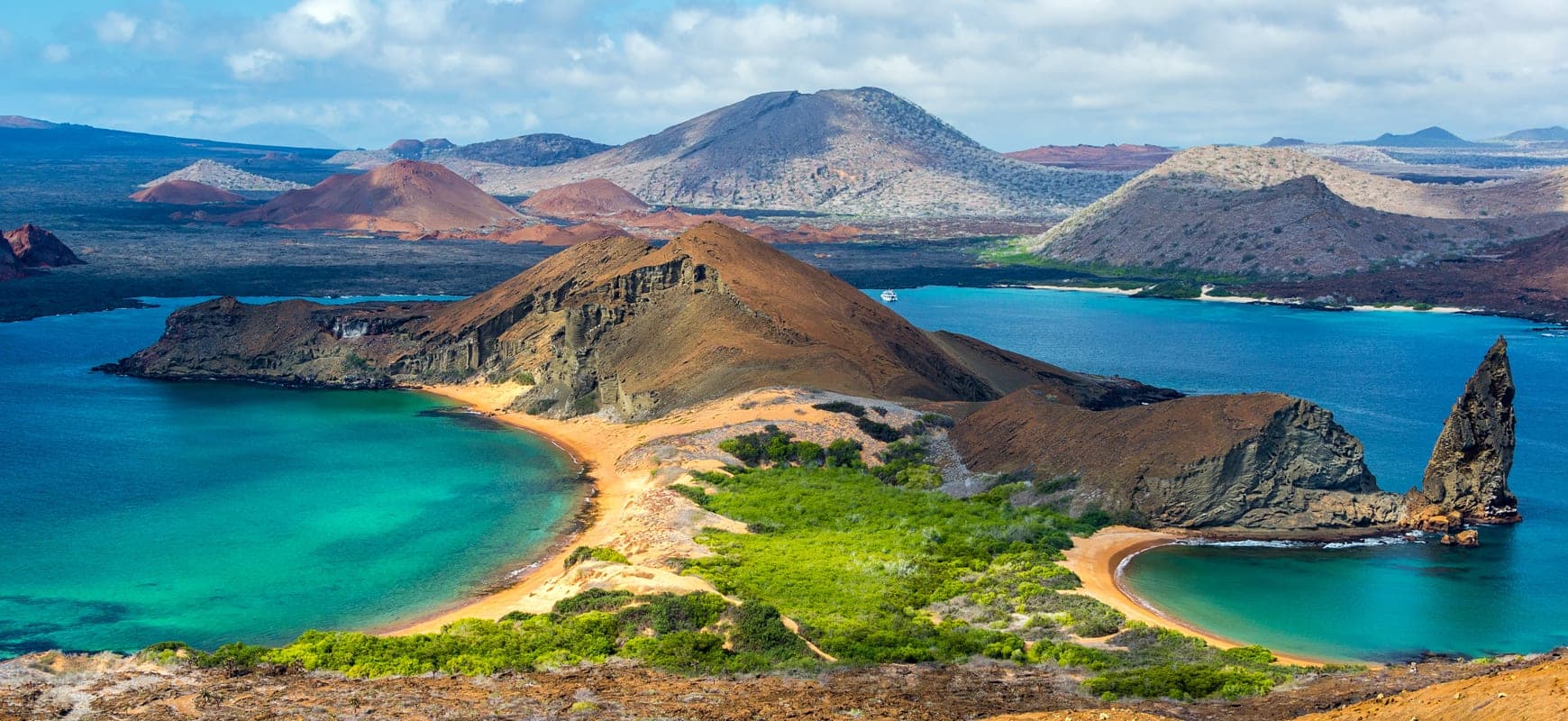Diving in Galapagos
Scuba diving this small group of volcanic islands is a unique experience. The Galapagos exudes natural beauty and boasts an incredible diversity of both land and marine life, from penguins to marine iguanas to seahorses to hammerheads to rays to whale sharks and sea lions. Punta Carrion is a liveaboard favourite site.
For many, scuba diving in the Galapagos Islands is a lifetime ambition. The Pacific ocean west of South America has long been a favourite for underwater addicts, but this small group of volcanic islands off the coast of Ecuador elevates diving to another level. Galapagos scuba diving introduces visitors to a world of unprecedented natural beauty, containing life not found anywhere else, and a sense of wilderness that will appeal to any fan of the great outdoors. Diving in the Galapagos is possible as part of both liveaboard trips and resort based packages - it's often recommended for tourists to witness the on land action as well which can be almost as enthralling as the ocean, again with much of the wildlife unique to these islands.
It's a place which, excuse the cliche, needs to be seen to be believed, capable of fulfilling the expectations and more of any serious scuba diver.
10 Liveaboards in Galapagos
Explore all liveaboards
Aqua
Galapagos-
- from $ 499 / day
- 9.0 Superb
- 142reviews

Humboldt Explorer
Galapagos-
- from $ 420 / day
- 8.8 Fabulous
- 100reviews

Galapagos Aggressor III
Galapagos-
- from $ 585 / day
- 9.1 Superb
- 93reviews

Calipso Dive
Galapagos-
- from $ 629 / day
- 9.4 Superb
- 68reviews

Tiburon Explorer
Galapagos-
- from $ 798 / day
- 9.7 Exceptional
- 78reviews

Galaxy Diver II
Galapagos-
- from $ 710 / day
- 9.5 Exceptional
- 36reviews
Diving in Galapagos FAQ
What marine life can I expect to see in Galapagos?
There are many diving destinations that boast a particular animal or creature in abundance, be that a certain species of Shark, a specific type of coral, or maybe a rare kind of Whale. Yet very few are able to offer almost every big name of the underwater world, all in a single place in pristine and natural conditions. The Galapagos Islands are one of these rare areas. Dive spots in the Galapagos feature an unparalleled diversity of marine life, due in some part to the region being a meeting point of a number of ocean currents. Where else can you see Penguins, Marine Iguanas, Hammerheads, Whale Sharks, and Sea Lions all in the same afternoon? Not only will diving at the Galapagos allow divers to see the likes of these, but it'll also normally be in great conditions and the animals are often present in huge numbers. Along with schools of circling Hammerheads, frequently seen are Silky Sharks, Blacktips, and of course the Galapagos Shark. Eagle Ray's dart through the blue along with cruising Mantas, adding to the spectacle which will include Groupers, Batfish, Snapper, and even Seahorses in the shallower sections. The list of vibrant life on show is truly endless, rightfully propelling the Galapagos to the very peak of the scuba diving world
What are the best dive sites in Galapagos?
The Galapagos Islands have so many world class dive sites to choose from, it's hard to know where to start!
To the north of the Galapagos archipelago lies Wolf Island, named after geographer Theodor Wolf. Turtles and multitudes of sharks are always present here, particularly groups of Hammerheads and Silkys, along with dolphins and sea lions. If the season and conditions are right, Whale Sharks can be seen here too. Wolf Island often forms part of a liveaboard dive trip, taking in many different sites of the Galapagos region.
When in the Galapagos, scuba diving trips are just not complete without a visit to Darwin Island. Like Wolf Island, it's located to the very north of the islands and most commonly visited on longer trips. The reefs are unbelievably healthy, supporting a wide range of marine life, including schools of sharks and reef fish, such as Angelfish, Batfish, Parrotfish, Trumpetfish and Barracuda. Mantas and Eagle Rays are among the larger visitors to this spectacular site too.
Punta Carrion is a favourite site within the Galapagos Islands. The conditions are often straight forward here, allowing divers to concentrate on the fantastic array of tropical life in view. As with much of scuba dives in the Galapagos, sharks are frequently sighted, specifically White Tips, Hammerheads and the unique Galapagos Shark. A lot of the action is between 12 and 18 metres, ensuring plenty of bottom time during which visitors are likely to see Mobula Rays, Sea Lions and Creole Fish.
Perhaps the coldest experience divers have when diving in the Galapagos is at Punta Vicente Roca, where water temperatures drop but with this attracts an even greater variety of life, much of which cannot be seen elsewhere. Mola Mola (the Sunfish) commonly frequent this site, growing to giant sizes whose unique body shape is sure to wow anyone. The sandy bottom at 22 metres is home to Red Lipped Batfish, and if you look up it's not uncommon to catch a glimpse of the rare Galapagos Bull Shark. Penguins and Sea Lions are both a common feature in any dive undertaken here also.
Cabo Marshall is the Ray capital of the Galapagos. Giant Manta Rays, in particular, come here in search of both feeding and cleaning stations. Although not guaranteed to be seen, there's still a good chance of witnessing these majestic animals gliding effortlessly through the blue. Mobula and Cow-nose rays complete the set here, both sighted frequently by divers. This site also has its fair share of White Tips, Hammerheads, Turtles and Sea Lions.
Cabo Douglas, off Fernandina Island, is the place to view playful Galapagos penguins dart past you with incredible speed. Conditions are normally perfect for drift diving, allowing divers to sit back, relax and let the current take them past the many wonders on show, including Marine Iguanas, Sea Lions and Sea Turtles. All the usual reef fish are present in healthy numbers, such as Box Fish, Parrotfish and Creole Fish.
What's the best time to dive in Galapagos?
Diving in the Galapagos is great all year round. There are two seasons - wet and dry. The wet season runs from January to June and offers the warmer water temperatures of between 20 and 25 degrees Celsius. The dry season, albeit with water temperatures dropping a little to around 19 - 23 degrees Celsius, is normally the busiest time of year with a high chance of Whale Shark sightings. It's a good idea to bring plenty of exposure protection due to the cooler underwater temperatures. Some say that the best season to visit the Galapagos or an ideal time, is between January and May when the air temperature is warm and the weather more reliable, and when encounters with Mantas and Hammerheads are particularly common.
What's the recommended experience level for diving in Galapagos?
Several dive sites within the Galapagos archipelago are suitable for new divers, with calm, gentle and shallow conditions allowing for easy, relaxed scuba diving. It's important to ask your operator first though because there are a number of places around the islands that are best suited to the more experienced and advanced. In these areas, currents can be strong, the surface choppy, and rocks an obstacle, although once several metres below things tend to calm down. As mentioned, if you're a little nervous or unsure, simply speak to your guide and voice any concerns - although enjoyment is the main goal, safety is their top priority.
How do I get to the Galapagos Islands?
One of the main beauties of the Galapagos and a reason it has remained so untouched and preserved is its remoteness. As such, it requires a bit of travelling to get there, but the reward of some of the planet's best diving environments will more than make up for it!
Tourists will need to fly into Ecuador, landing at one of the 2 international airports (Quito or Guayaquil) from overseas, before catching a connecting domestic flight to one of the islands, normally San Cristobal, or sometimes Baltra. Dive boats commonly start their itineraries from either of these - if you have organised a Galapagos liveaboard dive trip then it's highly likely the operator will pick you up from the airport as part of the tour.
10 Liveaboards in Galapagos
Explore all liveaboards
Aqua
Galapagos-
- from $ 499 / day
- 9.0 Superb
- 142reviews

Humboldt Explorer
Galapagos-
- from $ 420 / day
- 8.8 Fabulous
- 100reviews

Galapagos Aggressor III
Galapagos-
- from $ 585 / day
- 9.1 Superb
- 93reviews

Calipso Dive
Galapagos-
- from $ 629 / day
- 9.4 Superb
- 68reviews

Tiburon Explorer
Galapagos-
- from $ 798 / day
- 9.7 Exceptional
- 78reviews

Galaxy Diver II
Galapagos-
- from $ 710 / day
- 9.5 Exceptional
- 36reviews











